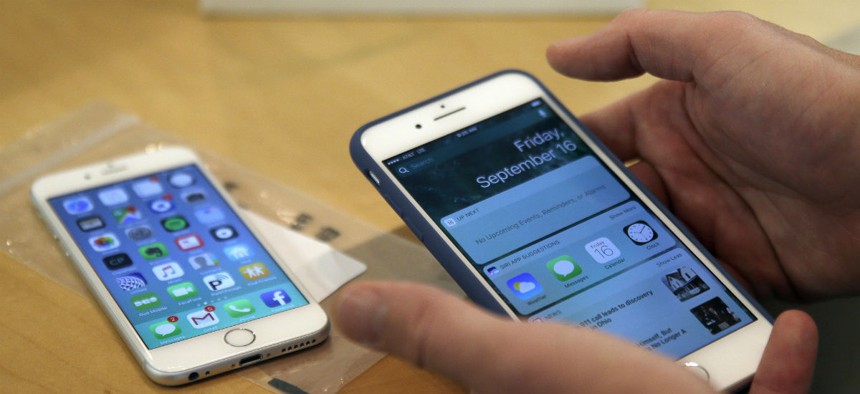Apple’s Upending the iPhone with a $1000 Model Featuring Curved Glass and—Wait for It—a USB Port

A customer sets up his new iPhone 7 Plus, right, as he switches from an iPhone 6 at the Apple Store on Michigan Avenue during the release of the Apple iPhone 7 in 2016. Kiichiro Sato/AP
The next iPhone's different look could be intriguing for some consumers.
Apple plans to release three new smartphones this year, ten years after the launch of the first device in 2007. The launch will include two “S” cycle devices, perhaps called the iPhone 7S and 7S Plus. According to The Wall Street Journal (paywall), it will also include a third, higher-end iPhone that may look markedly different from its predecessors.
As others have hinted at recently, an iPhone may be released this year with a curved organic light-emitting diode (OLED) screen, which provides brighter, more vivid colors than Apple’s usual liquid-crystal displays (LCD). The Journal reports that the new screen will be produced by Samsung, and will only feature on the third, high-end iPhone—there aren’t enough screen suppliers to build all three models. (The company generally sells between 40 and 70 million phones a quarter.)
It’s not clear how else this luxury iPhone may differentiate itself, but it’s expected to cost around $1,000, well above the $650 and $750 starting price of regular iPhones and iPhone Pluses. What these curved screens will actually look like, and whether they’ll be markedly different from Samsung’s own phones with curved screens (such as the Galxaxy S7 Edge and the fateful Note 7), or be more than just a gimmick, is also unclear.
That the next iPhone looks different and costs more could be intriguing enough for some consumers. The iPhone 7, which offered significant internal upgrades over the last iPhone, was criticized by many reviewers for looking identical to it, and the model before it. “Analysts say Chinese consumers feel more motivated to buy a new phone when it has a different look that gives it appeal as a status symbol,” the Journal’s Takashi Mochizuki says.
On all forthcoming iPhone models, there may be frustrating changes ahead: The new generation will apparently charge via USB-C cable, eschewing the Lightning charging cable that Apple introduced for its mobile devices five years ago. Apple recently replaced all the ports on its new laptops with USB-C ports, so bringing the iPhone to the USB-C standard makes sense. Unfortunately, it also renders just about every accessory and cable sold over the last five years useless. (Confusingly, Apple’s brand-new AirPods wireless headphones require a Lightning cable.)
None of the three new phones will have a home button, according to the Journal. This isn’t that a surprise, given that current iPhones don’t have physical buttons, just touch-sensitive areas that triggers certain actions. The next iPhones will be flush across the front, with a “function area” that you can tap below the main screen, according to MacRumors. Apple wasn’t immediately available to comment on these reports.
All these updates may help the phones resist water and fit better in Apple’s hardware ecosystem, but they do leave one wondering about their benefits. Every iPhone, and just about every other flagship smartphone on the market, is a pocket supercomputer with tons of space, beautiful screens, and excellent cameras. Samsung has had curved OLED screens for a few years now—to the point where it’s the only company that can supply Apple the amount it needs. It also has wireless charging, tiny phone-mounted styluses, and all sorts of other inventions. So while Apple’s hardware has always been the highest quality, ten years after the launch of the first iPhone, is it still leading the market?
Apple traditionally announces new iPhones in September. However, the first iPhone was announced in January 2007 and released over the summer, so perhaps in this anniversary year, we’ll see what a $1,000 iPhone looks like a little sooner.
NEXT STORY: Bid protest continues to stall FirstNet award





